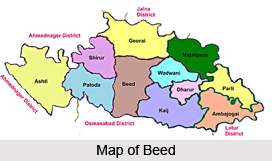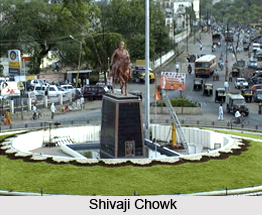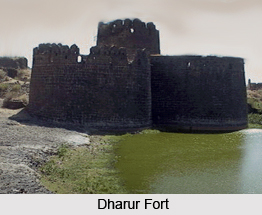 Beed is a town, which is the administrative headquarters of the Beed district located in the central part of Maharashtra. It is the largest urban area in the district with a total population of 138,096 according to 2001 census. Nearly 36% of the district lives in urban areas. With its distinctive climate and pristine treasures Beed has a very rich history.
Beed is a town, which is the administrative headquarters of the Beed district located in the central part of Maharashtra. It is the largest urban area in the district with a total population of 138,096 according to 2001 census. Nearly 36% of the district lives in urban areas. With its distinctive climate and pristine treasures Beed has a very rich history.
Beed was a part of the state of Hyderabad under the Nizams, who were once the close allies of the British Empire in India. After India got her independence, the state was annexed to India in September 1948. In 1956, Beed became a part of the "Bombay Presidency". On May 1, 1960 Bombay Presidency was again divided to form the two states of Maharashtra and Gujarat. Marathi dominant Beed became part of Maharashtra. There are numerous historical buildings situated in the town. These include temples, mosques, shrines, gates and a long degenerating wall of an ancient citadel, which protects a part of the old town from rare but violent floods of Bendsura River.
The exact geographical location of Beed is at 16.65° N 74.13° E. It has a mean elevation of 530 metres (1738 feet). Beed is located on the Deccan Plateau, on the banks of `Bendsura` a sub-tributary of Godavari. Bendsura divides the town into smaller eastern and bigger western sections. The Balaghat range is close by. The soil of the area is rough and rocky largely consisting of basalt. Thin deposits of fertile black soil are found in the northern part and in the south at the western bank of Bendsura. The town experiences semi-arid, warm and dry climate. Summers are lengthy, extending from the middle of February to June. Average temperatures in summer vary between 31 degree C to 40 degree C. Winters are short with temperatures between 12 degree C to 20 degree C. Rains are inadequate and take place only during the monsoon from mid June to September. The average annual rainfall is 666 mm.
As per the 2001 India census, Beed has a population of 138,091. Males make up 52% of the population and females amount to 48%. The average literacy rate of the town is 72%, higher than the nationwide standard of 59.5%. 78% of the males and 66% of the females are literate. 14% of the population consists of children less than 6 years of age. This town is home to people of various religions like Hindu, Muslim, Buddhist, Jain, Christian and Sikh. Since the town is the district headquarters of the Beed district, it harbors a number of district and local administrative offices including district and municipal councils, district and session courts and offices of district collector and superintendent of police.
The history of the foundation of the town is very vague. A number of legends enlace the history of the origin of this town. There is a certain legend linked to the town. When Ravana, the demon king of Lanka, abducted Sita (wife of Rama) and was forcefully carrying her to Lanka, Jatayu, an eagle tried to prevent him. But Ravana slashed its wings and the injured Jatayu fell to the ground. When Rama came to the place in search of his beloved wife, Jatayu managed to tell him what has happened and then died. It is believed that the place where he died is in Beed town. A temple has been erected in the town in honor of Jatayu.
Another legend unveils the fact that Beed was an inhabited place in the era of the Pandavas and the Kurus. It was then known as Durgavati and later as Balni. When Champavati, the sister of Vikramaditya, took possession of the town, she renamed it as Champavatinagar. After her reign, the Chalukyas, the Rsshtrkutas and the Yadava dynasties subsequently ruled the town before falling under the Muslim rule. On the basis of archaeological remains historians opine that the town of Beed has probably been founded by the Yadava rulers (1173 - 1317) of Devagiri (now Daulatabad). The town finds mention in `Tarikh e Firishta` (Gulshan e Ibrahimi), compiled in the 17th century by a Persian- Indian historian Muhammad Qasim Firishta (1560 - 1620). Firishta terms it `Beer`(which is the Arabic for well) referring to the advent of the ruler Muhammad Bin Tughluq and his army in the town. Famous English version of this book `History of The Rise of Mohammedan Power in India` by John Briggs has been published a number of times in India and abroad. The origin of the present name of Beed is very ambiguous. Regarding this, there are two different opinions. According to the first opinion, the region, located at the foot of the Balaghat Range, appears as if it is in a hole; therefore it was named `Bil` (the word in Marathi means hole) which was gradually corrupted to `Bid`. The second opinion is that a certain `Yavana` ruler of prehistoric India named it `Bhir` (Persian for water) after coming across water at a very low depth. Bhir is believed to have become Beed with the passage of time.
If the town was set up in Yadava period then perhaps it took place in Singhana`s (1210 - 47) period, when the Yadava dynasty was at the epitome of its glory. It is possible that Singhana has built the town and also the Kankaleshwar temple. The town came under the control of the Muslims for the first time in 1317 with the capture of Devagiri by Qutb-ud-Din Mubarak Shah (1316 - 20), the last Khilji, and the subsequent annexation of the Yadava dynasty to the Khilji dynasty. The town was under the control of the Khiljis till 1320 when Ghiyas-ud-Din Tughluq (1320 - 25) took possession of it. In 1327 Muhammad bin Tughluq (1325-51) turned Daulatabad into his capital. Tughluq and his army camped in the town in 1341 while travelling from Warangal to Daulatabad. On the way the emperor lost one of his teeth, which he ordered to be buried and consequently a tomb was built at the place. The tomb can be found even now in the village of Karjhani at a distance of about 12 km from the town. In 1347 Beed fell under Bahmani rule when Hasan Gangu (1347 - 58), the originator of the Bahmani dynasty, revolted against the Tughluq rule and established himself on the throne of Daulatabad under the name of Ala-ud-Din Bahman Shah. Muhammad Tughluq came to Deccan to counteract the insurgent activities of the rebels. He fought with the rebels and again took possession of the province of Daulatabad, of which, Beed was a part. Hasan Gangu and other rebels escaped to Bidar and Gulbarga. Meanwhile, another rebellion broke out in Gujarat. The sultan started off to Gujarat after appointing Imad-ul-Mulk as governor in Deccan. Getting hold of this golden opportunity, Hasan Gangu attacked Daulatabad and seized Beed. After that the town stayed under Bahmani rule and flourished during the reign of Firuz Shah Bahmani (1397 - 1422). During the rule of Humayun Shah Bahmani (1451 - 61), famously known as Zalim (cruel), his brother Hasan Shah after mutinee and came to Beed.
 A Jagirdar (feudatory) of Beed, Habibullah Shah supported him. Humayun Shah sent an army and after a severe battle in the vicinity of the Kankaleshwar temple, the rebels were defeated. Habibullah Shah was killed and Hasan Shah was captured and taken to the capital. He was then put before a hungry lion. After the fall of the Bahmani dynasty the town came under the control of the Nizam Shahi rulers of Ahmadnagar. Numerous wars were fought in Beed between Nizam Shahi and Adil Shahi rulers of Bijapur to take possession of the town. In 1598 the Mughals seized Beed from Chand Bibi of Ahmadnagar. A year later Nihang Khan got hold of it but very soon it fell again into the hands of the Mughals. When Jahangir (1569 - 1627) was in power, Jan Sipar Khan was the administrator of the town. When Aurangzeb (1658 - 1707) was in power, he made Haji Sadar Shah the Naib-e-Subadar (assistant of governor) of Beed. Sadar Shah did some good alterations and construction in the town. He constructed Eid Gah (place of Eid prayer) and a new territory at an high altitude in the eastern part of the town, which is known as `Ghazi Pura` (now Islam Pura). The ruins of it can still be seen. In his time the financial system of the town also thrived.
A Jagirdar (feudatory) of Beed, Habibullah Shah supported him. Humayun Shah sent an army and after a severe battle in the vicinity of the Kankaleshwar temple, the rebels were defeated. Habibullah Shah was killed and Hasan Shah was captured and taken to the capital. He was then put before a hungry lion. After the fall of the Bahmani dynasty the town came under the control of the Nizam Shahi rulers of Ahmadnagar. Numerous wars were fought in Beed between Nizam Shahi and Adil Shahi rulers of Bijapur to take possession of the town. In 1598 the Mughals seized Beed from Chand Bibi of Ahmadnagar. A year later Nihang Khan got hold of it but very soon it fell again into the hands of the Mughals. When Jahangir (1569 - 1627) was in power, Jan Sipar Khan was the administrator of the town. When Aurangzeb (1658 - 1707) was in power, he made Haji Sadar Shah the Naib-e-Subadar (assistant of governor) of Beed. Sadar Shah did some good alterations and construction in the town. He constructed Eid Gah (place of Eid prayer) and a new territory at an high altitude in the eastern part of the town, which is known as `Ghazi Pura` (now Islam Pura). The ruins of it can still be seen. In his time the financial system of the town also thrived.
Beed was a very prosperous town during the Bahmani and Munhal rule. Many gardens were also built in the town during this period. In 1724 Nizam-ul-Mulk Asaf Jah established the Asaf Jahi dynasty, capturing Deccan from the Mughal emperor Muhammad Shah (1719 - 48). All the seven rulers of this dynasty were called Nizams. The period in office of the sixth Nizam Mahbub Ali Khan (1869 - 1911) was ironically a landmark in the history of Beed. Rebellions, devastating famine and floods occurred during his reign. Jagirdars were substituted by Awwal Taluqdars (Collectors) in his reign and Jivanji Ratanji became the first collector of Beed in 1865. Districts were formed and the Beed district formally came into being in 1883. The Nizams were the political allies of the British Empire in India. During the struggle for the independence during the 19th and 20th centuries they tried to curb the feelings of patriotism which were spreading due to national activities. Supporters of independence in the state of Hyderabad were againt the friendship of the Nizams with the oppressive British rulers. Beed was the first place in Marathwada area to have started the freedom struggle in 1818. In 1818 during the reign of Nizam Sikandar Jah (1803 - 29) a rebellion broke out in Beed under the guidance of Dharmaji Pratap Rao. The ruling Nizam sent the Risala of Navab Murtaza Yar Jang under the authority of British Lieutenant John Sutherland. The revolutionary leader and his brother were imprisoned and a potentially powerful rebellion movement in Beed came to an end. After this incident, many more rebellions were crushed. But the feelings of rebelliousness could not be concealed and various movements under the headship of Swami Ramanand Teerth and Govind Bhai Shroff continued in the region. After independence, Mir Osman Ali Khan, the last of the Nizams, was unwilling to unite with the Indian Union. Finally, on September 12, 1948 a military action `Operation Polo` commenced and the state was easily seized within six days.
There are many places of historical importance in Beed. The Kankaleshwar Temple is the oldest and the most striking building in the town. The pattern of the architecture traces the time of its construction to the Yadava period, in all probability during the reign of Singhana, who also founded Devagiri. The design of this temple bears certain resemblances with the temples at the famous caves of Ellora. Positioned at the center of a small lake in the eastern part of the town, the temple is made up of black stone and has admirable human and divine figures carved all around. A fair is held near the temple during every Mahashivratri. The Jama Masjid, a mosque constructed during the time of Mughal emperor Jahangir by his official Jan Sipar Khan, is one of the largest mosques in Beed. Located in the heart of the town at Quila (citadel) it has three massive domes and four minarets. The Khandoba Temple lies on the eastern hills. Constructed in Hemadpanti fashion, it is often looked upon as the symbol of the town. Two proportionate, octagonal `dipmal` (towers of light) rising to a height of 21.33 meters (70 feet) stand in front of the temple. The towers have figures of humans and animals engraved on them.
There are two opinions regarding the construction of this temple. The first says that it was put up by Sultanji Nimbalkar, a Jagirdar of the Nizam period. According to the second opinion, it was built by Mahadji Scindia. Then there is the Shahinshah Wali Shrine (a sufi shrine), in the vicinity of which, a fair is held every year. Another sufi shrine in the town is the Mansur Shah Shrine, whose dome is made of marble. The renowned Khazana Well is located at a distance of 6 km south of the town. It was built by Salabat Khan, a Jagirdar of Beed in the age of Murtaza Nizam Shah of Ahmadnagar. It is said that the water level in this well remains unaffected even during droughts. Apart from these, the town has numerous hiostoric gates and a small fort.
The culture of the Beed town is mostly Maharashtrian. Religious customs are meticulously followed in marriages and other functions. Family, customs and religion still bears a lot of significance in the society. Food is principally vegetarian, but peppery non-vegetarian food is also accepted. A number of restaurants, dhabas and roadside food shops prepare non-vegetarian food. Chicken is possibly the most popular non-vegetarian food in all factions of the society, except the Jain who are a pure vegetarian community. The modern generation; particularly males, wear western outfits. Shalwar Khamis is popular among youthful girls. Married women wear Saris and bodice. Traditional outfits are however popular among the elderly people. Diwali, Holi, Dasehra, Eid-ul-Fitr, Eid-ul-Adha and Buddha Jayanti are the most important festivals. New housing structures are principally concrete based, but in some places, mud and mortar houses having metal sheet roofs are also widespread.
 The town of Beed is reachable only by road. The National highway no 211 that runs from Ahmadabad to Hyderabad passes through the town. Maharashtra State Road. Some private and state owned travel agencies offer bus services to the main cities of the state. The closest domestic airport is Aurangabad (133 km), while the nearby international airports are Mumbai (418 km) and Pune (250 km). The closest railway stations are Vaijnath (120 km), Aurangabad (133 km) and Ahmadnagar (145 km). Auto rickshaw is the single means of public transport within the town.
The town of Beed is reachable only by road. The National highway no 211 that runs from Ahmadabad to Hyderabad passes through the town. Maharashtra State Road. Some private and state owned travel agencies offer bus services to the main cities of the state. The closest domestic airport is Aurangabad (133 km), while the nearby international airports are Mumbai (418 km) and Pune (250 km). The closest railway stations are Vaijnath (120 km), Aurangabad (133 km) and Ahmadnagar (145 km). Auto rickshaw is the single means of public transport within the town.
The education in the town of Beed is provided in three mediums, namely English, Marathi and Urdu. There are some primary and secondary schools as well as colleges in the town. The important educational institutions include one Agricultural Engineering college, one Engineering College, two diploma Engineering Colleges (one is state run), one Homoeopathic Medical College, one Diploma Pharmacy College and one Industrial Training Institute. There are various private clinics and hospitals, as well as a state run 300-bed hospital.



















